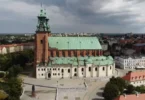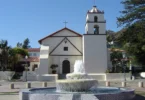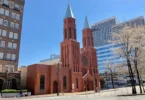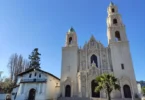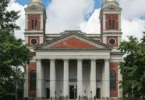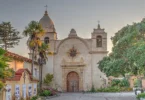Introduction

The Basilica and Royal Sanctuary of the Most Holy Virgin of the Head is a revered Marian shrine nestled in the heart of the Sierra de Andújar Natural Park, specifically in the area known as Cerro del Cabezo, located approximately 32 kilometers north of the city of Andújar, in the province of Jaén, Spain. This sacred site is dedicated to the veneration of the Virgin of the Head, who holds the title of patron saint of Andújar, a devotion that was formally recognized through a papal bull issued by Pope Pius X on March 18, 1909. Later, the Virgin was also proclaimed patroness of the Diocese of Jaén by Pope John XXIII, through another papal bull dated November 27, 1959.
A significant moment in the sanctuary’s recent history occurred on October 25, 2008, when Pope Benedict XVI granted Plenary Indulgences to the faithful visiting the shrine. This act marked a crucial step toward its elevation to the rank of minor basilica, a distinction officially conferred on April 21, 2010 by the Congregation for Divine Worship and the Discipline of the Sacraments, under the leadership of Cardinal Prefect Antonio Cañizares Llovera. The decree was solemnly read by Bishop Ramón del Hoyo López during the annual pilgrimage mass held on April 25 of that year. Further enhancing the basilica’s spiritual and liturgical significance, its new altar was consecrated on July 3, 2011.

Origin and Apparition (1227)
The origins of the devotion to the Virgin of the Head are rooted in a profound and miraculous event dated to the night between August 11 and 12, 1227. According to longstanding tradition, Juan Alonso de Rivas, a shepherd boy from the nearby town of Colomera, was searching for a lost cow near the hills north of Andújar. Juan Alonso, notably afflicted with paralysis in one arm, suddenly witnessed a supernatural phenomenon: a radiant light shining within a rock hollow on Cerro del Cabezo. Drawn by this luminous glow, he approached cautiously and discovered an image of the Virgin Mary resting on a pedestal. The Virgin reportedly spoke to him, commanding him to return to Andújar and instruct the townspeople to build a chapel in her honor on that mountain. The shepherd’s initial doubt was quelled when the Virgin healed his paralyzed arm upon his faithful request to demonstrate the miracle. Empowered by this divine sign, Juan Alonso carried the message to the city, displaying his now-healed arm as proof. This event ignited a fervent devotion among the people of Andújar and laid the foundation for the sanctuary’s eventual establishment.
Construction and Early Sanctuary (1287–1304)
Following the apparition and miraculous healing, the Brotherhood of Our Lady of the Head was formed to organize the construction of a sanctuary at the sacred site. Building began in 1287 atop the highest hill of the Sierra Morena, locally known as El Cabezo—so named for a large rock formation resembling a human head. The construction, completed by 1304, resulted in a modest yet spiritually significant church that became a focal point for pilgrims from the region. Over time, the sanctuary underwent expansions and renovations, notably at the end of the 16th century, reflecting growing devotion and the need for a larger, more magnificent space for worship. The sanctuary’s name, “de la Cabeza,” remains a homage to the distinctive hill and its legendary rock.
Since 1930, the religious order of the Trinitarians has been entrusted with the sanctuary’s spiritual care. They are responsible not only for daily worship but also for preserving the Virgin’s cult and accompanying the sacred image during the annual pilgrimage procession in April. It is traditional for two Trinitarian friars to ride alongside the Virgin’s float during the pilgrimage, extending blessings to children and devotees along the route.
The Canonical Coronation of 1909
The significance of the Virgin’s devotion was officially recognized by the Catholic Church when Pope Pius X granted a canonical coronation on November 10, 1907. This formal act elevated the image’s status, affirming its spiritual importance to the faithful. Preparations culminated in 1909 when the Virgin’s image was temporarily transferred to the Parish Church of Santa María la Mayor in Andújar on April 20. Three days later, on April 23, the crowns for the Virgin and Child Jesus were blessed in a grand ceremony led by Archbishop José Meseguer y Costa of Granada. This ceremony drew clergy, nobility, and civic leaders, including the Count of Torrejón and the Civil Governor of Jaén. The crownings took place on a specially constructed altar on the Colón Esplanade, where a large crowd gathered to witness the event. Later that evening, the effigy was paraded through Andújar’s streets in a solemn procession marked by intense devotion and celebration. In a further honor, in 1950, the Virgin of the Head was bestowed the military title of Captain General of the Spanish Armies, reflecting her revered position as protector and patroness of Spain’s armed forces.

The New Effigy and the 1960 Re-Coronation
The sanctuary and its treasures suffered devastating losses during the Spanish Civil War, including the original sacred image. To replace the lost effigy, a new statue was commissioned and completed by 1960. This new image was solemnly crowned in Andújar by Bishop Félix Romero Mengíbar, symbolizing both continuity of faith and a spiritual reparation for the destruction endured during the war.
The Pilgrimage: Origins and Historical Significance
The annual pilgrimage (romería) honoring the Virgin of the Head is one of Spain’s oldest religious festivals, with roots that are believed to date back to the late 15th century during the reign of the Catholic Monarchs, although documentary evidence for its precise origins remains unclear until the early 16th century. By 1505, records show the festival was celebrated on the last Sunday of April, establishing a longstanding tradition that draws thousands of pilgrims each year. The pilgrimage is characterized by processions through the rugged natural landscape of the Sierra de Andújar, culminating in a mass and celebration at the sanctuary.
Prominent historical figures attended or wrote about this pilgrimage. Miguel de Cervantes participated in 1592 and described the event in his novel Los trabajos de Persiles y Sigismunda. The pilgrimage also played a role in the conversion of Muley Xeque, Prince of Fez, who attended in 1593, converted to Christianity, and was baptized in the monastery of San Lorenzo de El Escorial with King Philip II as a godparent. This event inspired literary works by Lope de Vega and Pedro Calderón de la Barca, cementing the pilgrimage’s cultural significance.
The Spanish Civil War and the Siege of the Sanctuary (1936–1937)
During the tumultuous years of the Spanish Civil War, the sanctuary took on a role far beyond a place of worship. In July 1936, approximately two hundred members of the Civil Guard from Jaén, who supported the Nationalist uprising, along with their families and several civilians, sought refuge in the sanctuary. For nine grueling months, they endured a siege by Republican forces, who vastly outnumbered and constantly bombarded the sanctuary. Despite shortages of food, medicine, and ammunition, the defenders held firm under the leadership of Captain Santiago Cortés González. Eventually, the sanctuary was heavily bombed and reduced to ruins. On May 1, 1937, Captain Cortés was mortally wounded, and the defenders surrendered. The Republicans took control, marking the sanctuary’s destruction and the loss of its artistic treasures, including the original image of the Virgin. The Republican command considered the conquest of the sanctuary a significant symbolic victory, using it as propaganda to demonstrate their strength and moral superiority during the conflict.
Cultural Legacy: The Sanctuary in Film and Literature
The heroic defense and tragic fall of the sanctuary were immortalized in the 1949 film El Santuario No Se Rinde (“The Sanctuary Does Not Surrender”), a Nationalist-era production intended to glorify the bravery and sacrifice of the defenders. Beyond cinema, the sanctuary’s history, and the devotion to the Virgin of the Head continue to inspire literary works, religious traditions, and cultural events in Spain, maintaining its role as a powerful symbol of faith, resilience, and regional identity.
Architecture of Basilica and Royal Shrine of Our Lady of Cabeza, Andújar, Spain

Architectural style : Gothic architecture.
Artistic Heritage
The Descent of the Virgin
One of the most visually powerful and emotionally significant traditions linked to the Sanctuary of Our Lady of the Head is the annual Descent of the Virgin during the pilgrimage in April. This event, deeply rooted in Andalusian Catholic devotion, sees the revered image of the Virgin carried down the winding roads of the Sierra Morena, surrounded by thousands of pilgrims. The procession is both a liturgical and artistic expression, marked by elaborate decorations on the Virgin’s float, colorful banners, and traditional costumes. The scene is a living tableau of faith, where religious symbolism, music, and local culture blend into a unique form of spiritual art. Trinitarian priests accompany the image and offer blessings, bringing children and objects close to the Virgin for protection and healing.
The Sacred Heart by Mariano Benlliure (1943)
Following the destruction caused by the Spanish Civil War, the Sanctuary lost many of its original sacred images. In 1939, General Queipo de Llano requested the renowned Valencian sculptor Mariano Benlliure to create a new image to replace those lost. Benlliure offered a plaster model from his workshop, and from this, the image of the Sacred Heart of Jesus was completed in 1943. The sculpture, marked by Benlliure’s refined realism and expressive detail, portrays Christ with a serene yet penetrating gaze, hands pointing to His heart in a gesture of divine love. The statue was so impactful that additional versions were produced for churches in Madrid and Alicante. Today, it remains preserved in the Sanctuary and is one of its most treasured devotional artworks.
The Agonizing Christ
Another masterpiece by Benlliure found in the Sanctuary is the Cristo Agonizante (Agonizing Christ). Commissioned by the organization Obra Pro-Imagines en los Frentes de Combat, this sculpture was part of an initiative to provide spiritual comfort to soldiers during wartime. The image depicts Christ crucified on a flat cross, with a distinctive halo of sanctity incorporated into the crossbeam itself. The portrayal is minimalist yet profoundly moving, emphasizing the humanity and suffering of Christ. This statue is located in a niche on the left side of the sanctuary’s interior and serves as a focal point for prayer and contemplation. The realism and intensity of the sculpture make it one of the most emotionally compelling works in the sanctuary.
Architecture
Original Medieval Construction
The Sanctuary of Our Lady of the Head was constructed between 1287 and 1304 on the summit of La Cabeza hill, a location both strategically elevated and spiritually significant. The original building was designed in a medieval style, likely a mix of late Romanesque and early Gothic elements, with thick stone walls, narrow windows, and a fortress-like appearance suited to its remote and mountainous setting. The sanctuary’s role as a site of pilgrimage and refuge shaped its architectural form, giving it the dual purpose of both church and stronghold.
Renaissance Renovation
Significant renovations were undertaken at the end of the 16th century, transforming the sanctuary into a more refined and artistic space. These changes reflected the Renaissance influence prevalent in Spain during the Counter-Reformation, emphasizing beauty and order in sacred spaces. Architectural additions included new chapels, decorative columns, and a more sophisticated altar area. The Renaissance renovation introduced classical proportions, harmonious lines, and elaborate ornamentation, adding spiritual grandeur to the sanctuary’s original medieval austerity.
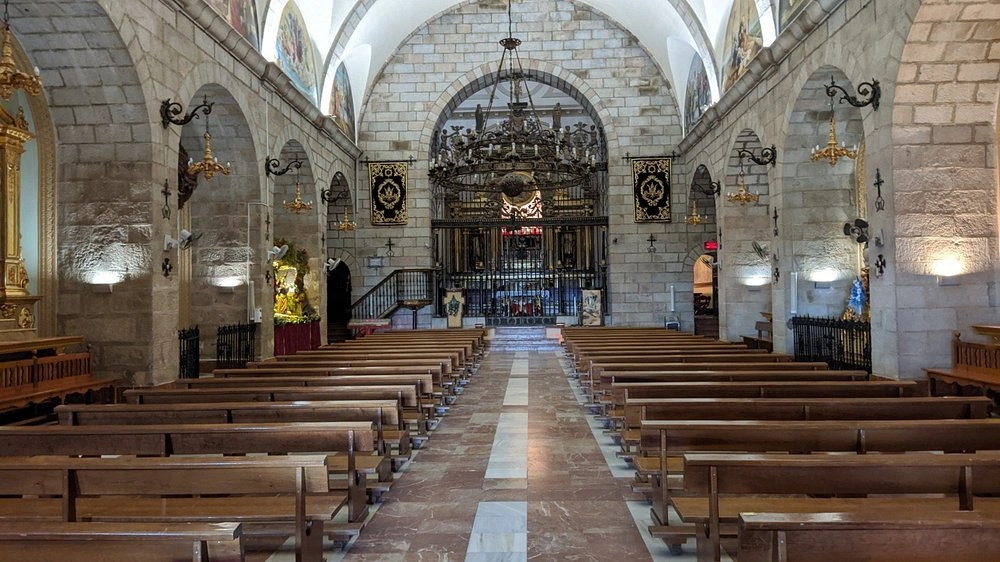
Interior Design and Devotional Art
The interior of the sanctuary features a basilica layout, with a central nave, side aisles, and an elevated main altar. The altar area was most recently renovated and consecrated in 2011, emphasizing its continuing role as a liturgical center. The walls are adorned with religious artwork, including paintings, reliefs, and sculptures that narrate the story of the Virgin’s apparition and miracles. Niches throughout the sanctuary house sacred images, such as the Agonizing Christ, while votive offerings from pilgrims—candles, silver plaques, and embroidered items—add a deeply personal layer to the space. The combination of wood carvings, gilded altarpieces, and devotional art creates an environment that is both sacred and artistically rich.
Symbolism and Sacred Space
The architectural symbolism of the sanctuary is integral to its identity. Perched atop La Cabeza hill, the sanctuary represents spiritual ascent, a journey both physical and divine. The massive stone walls and elevated position echo its role as a place of protection, especially during times of persecution or conflict, such as the Spanish Civil War. The blending of architectural styles—from medieval to Renaissance—reflects the continuity of faith across centuries. Every arch, statue, and niche contributes to the sanctuary’s function not just as a religious site, but as a spiritual monument to resilience, devotion, and artistic heritage.
Feast Day
Feast Day : last Sunday of April
The feast day of the Basilica and Royal Shrine of Our Lady of Cabeza in Andújar, Spain, is celebrated annually on the last Sunday of April. This date marks the culmination of the traditional pilgrimage (romería) honoring the Virgin of the Head, which is one of the oldest and most significant pilgrimages in Spain.
Church Mass Timing
Monday to Saturday : 12:00 PM , 6:00 PM , 8:00 PM
Sunday : 11:00 AM, 12:00 PM, 1:00 PM, 6:00 PM, 10:30 AM, 11:30 AM, 12:30 PM, 8:00 PM
Church Opening Time:
Monday to Sunday : 8:30 AM – 8:00 PM
Contact Info
Address : Basilica and Royal Shrine of Our Lady of Cabeza
Sanctuary of Virgen Cabeza, 46, 23748 Andújar, Jaén, Spain.
Phone : +34 953 54 90 15
Accommodations
Connectivities
Airway
Basilica and Royal Shrine of Our Lady of Cabeza, Andújar, Spain, to Federico García Lorca Granada Airport (GRX) A-4075, distance 2 hr 11 min (180.8 km) via A-44.
Railway
Basilica and Royal Shrine of Our Lady of Cabeza, Andújar, Spain, to Andújar Train Station, distance between 32 min (20.2 km) via A-6178.


